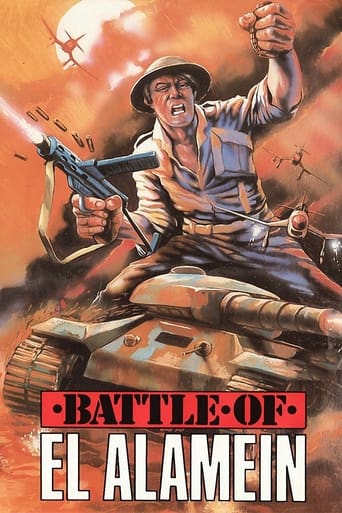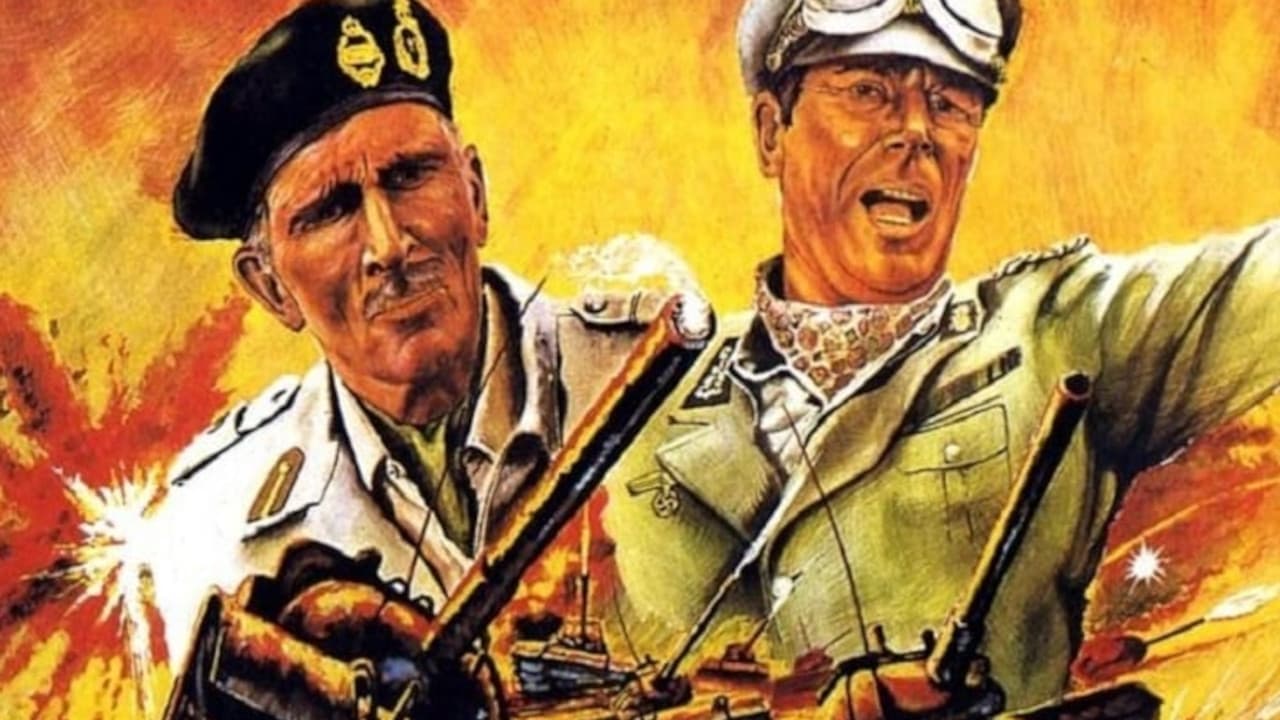Robert J. Maxwell
It's a dubbed Italian production in lurid color dealing with the Axis defeat by the British and colonials in North Africa. Now, I hate to call it "operatic." But at the very opening, an Italian unit is motoring towards the front, singing a jolly song, the feathers on their caps pluming, when they're fired upon by a British machine gun. You should see them die as they bravely attack the enemy position in mass waves. They're mowed down. But as each soldato is shot, the director (Calvin Jackson Padgett, aka Giorgio Ferroni) has him throw up his arms, execute a few pirouettes, and fling himself dramatically to the sand. Maybe it's not a cinematic trope. Maybe Italian soldiers actually DO die in a distinctly regional way. Wait, I think I can see it. The British soldier clasps a hand to the wound, looks puzzles, and sinks uncomplainingly. The French die with a xenophobic curse on their lips. The Americans shout out capitalistic slogans as they stagger about, unwilling to yield to the "sure-enwinding arms of cool-enfolding death." Germans fall face-first at attention, Russians with a few last kicks from the hopak. I know I shouldn't be joking about deaths in combat. There's nothing funny about the reality, but the movie is sometimes a joke in itself and more or less invites such treatment.The movie takes us to the upper echelons and introduces us to Michael Rennie (dubbed) as Sir Bernard Law Montgomery, now taking charge of the British forces and kicking some butt. Once that's established, we visit Rommel drawing lines on a map, complaining that he has barely enough forces to contain the British, and explaining the situation to the real historical figure of General Bastico, whom Rommel in real historical life referred to as "Bombastico." It's a tense situation all right. The Brits have been forced back to the Egyptian border and Alexandria and the Suez Canal are threatened. At the same time, Rommel's supply pipeline has been practically severed by British air and submarine attacks, so he can't advance any farther -- no men, no tanks, no fuel, not even enough water. His men urinated into water-cooled machines. The film correctly states that he was losing 60 percent of his supplies, but it doesn't mention that the Italian naval code had been broken, so the Brits knew when his supply ships would leave Italy for Tripoli. At the battle, Rommel was outnumbered two to one in troops, in tanks, and in the air.It's not a bad film once you're able to get past the accidental qualities -- the dubbing, the often sluggish direction. The story sticks pretty close to actuality in depicting the overall military arrangements. I don't know about the details. All three sides -- Italian, German, and British -- are shown to have human qualities. No one is a sneering villain. Everyone makes a misjudgment from time to time. The location shooting is adequate. It's a desert all right. The special effects are of the period, and the musical score points us in the direction it invites our emotions to take. The repulse of the British patrol by the Italian Folgore (Lightning) Division of paratroopers is accurately described (except for the absence of tanks). Rommel commended the division for its bravery. The uniforms and helmets of the Italian troops are historically accurate.Yet there's an element of clumsiness throughout. A British scouting party advances. The pipers are playing their bagpipes. But the sound isn't that of bagpipes but of some sort of electronic horns and the tune sounds more Italian than Scottish. Who chose the voices that were dubbed later? Why are so many of them baritones and so often gravelly? Who decided that a lone man with a submachine gun, trying to hold off an armored car, should kneel out in the open instead of taking cover. And when a man is extremely thirsty and is given half a cupful to drink, why does he try to gulp it down and spill half of the precious water down his chin? What was Calvin Jackson Padgett thinking? Generally the Italians are portrayed as more humane than the Germans.The Germans aren't exactly cruel but an Italian soldier criticizes them for their willingness to leave a wounded man in front of them on the battlefield. "No sense risking more lives to save one," says the German officer. "How -- logical," sneers the Italian. (When John Wayne made the same decision in "Sands of Iwo Jima," the film gave him plaudits for his heroic self-discipline.) We -- the Brits, French, and colonial troops -- won the battle of El Alamein, but not because of any weaknesses in the Folgore Division. Vastly outnumbered and out gunned, they fought with everything at hand. The use of Molotov cocktails shown in the movie was not made up. Out of ammunition, some of the survivors retreated to Tunisia, where they fought again, while others surrendered at El Alamein. The battle, in fact all the battles of North Africa, were slugging matches, with both sides hemmed in by the Mediterranean on one side and the Qatarra depression, impassable to armor, on the south. It's not a bad movie. It's just that some of the elements -- the direction, the sound effect and so forth -- make it seem worse than it is.
jt_3d
The Battle for El Alamein is a cut above the other Italian WWII movies I've seen. It does have it's flaws though. Poor editing - as our heroic Italian warriors are being overrun by the Brits, everyone is getting ready to die. One guy tenderly caresses a photo of his son and laments that his son will never get to see his father. BOOM BOOM BOOM of explosions and cut to Montgomery casually leaning on on an armored personnel carrier. Only to come back later and find out that they weren't wiped out. What Happened?! There are other annoying cuts but that was the worst.The APCs are indeed M113s but the British did have something called the universal carrier which looks like an open top, cut down version of a 113. I'm willing to give that a pass.At one point we are in the British camp and they have real Sherman tanks, long barreled ones but they are Shermans. The Germans have M48s, I think they are. Both sides are painted tan. But in the final battle we have a line of M48s lined up on the ridge. It wasn't until the Italians said they were being attacked that I realized these were supposed to be British tanks. Most confusing.At any rate, this movie is a cut above the usual Italian war movie and is good enough for a watch. It's something different in that the roles are reversed and the Italians are the heroes and good soldiers and the allies are the faceless mob getting mowed down by the ton. Not that that is a good thing but it's a change of pace.
rickyrialto
From the British bulletin:The opposite resistance from the "Divisione Paracadutisti Folgore" is indeed admirable. The rests of the Italian division Folgore have resisted beyond every limit of the human possibilities.6450 paratroops, at the end of the battle only 340 survived. Some tanks on this movie looks like after war tanks. 25,000 Germans and Italians had been killed or wounded in the battle and 13,000 Allied troops in the Eighth Army. The glorious Division was destroyed during the 2nd El Alamein Battle. During this episode the V an VI Semoventi 75/18 Groups, and the DI Semoventi 90/53 Group operated under the 'Ariete' Division Command.
Michael A. Martinez
Italy, along with much of the rest of the world, was into producing lots of cheapo war movies (mostly WW2) during the late-60's. The trend died out with the disillusionment caused by the Vietnam war, as did the popularity of these "gung-ho" war films.Battle of El Alamein isn't such a film. It's probably the most objective and anti-war film made since ALL QUIET ON THE WESTERN FRONT. While the battle sequences are big and exciting, there's nothing glamorous about fighting this kind of war. The soldiers are all shown as equally miserable, barely eeking out an existence in a network of trenches on the sunbaked deserts of North Africa. While it primarily focuses on the heroics of an Italian division (the real-life Italian army was best known as one of the most poorly-led and low-morale armies at the time), the film doesn't get too preachy and while it villifies no one, only showing how some generals (especially the fictional Schwartz) inevitably swung the battle in their enemy's favor due to their impatience and misguided ideals.THE BATTLE OF EL ALAMEIN also does a great job of blending fictional characters with nonfictional ones (like Rommel, Montgomery, Von Thoma, and Stumme) in a nonfictional setting. While the battle itself is abridged and perhaps over-simplified to focus on the Italian division, that's perhaps best for the sake of narrative, character development, and making the emotional impact as strong as possible.Stylistically, the film is done fairly well in late-60's style, with plenty of zoom-lens technique, close-ups, etc. It does drag in spots but only due to the predictability because we KNOW that the axis is gonna lose, but it does a good job keeping the suspense high by showing the Italians taking heavy losses in every engagement. We never know which characters are gonna make it through and which ones aren't.Despite it's flaws, I doubt a better, larger, or more compelling depiction of the battle of El Alamein shall ever be made.


 AD
AD


